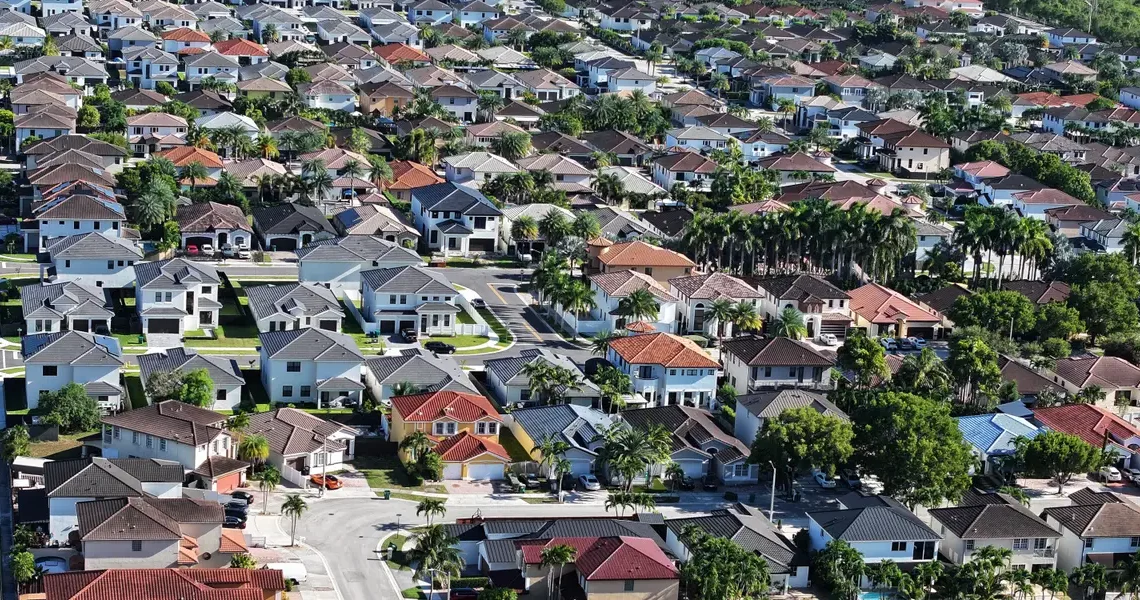As mortgage rates stay stubbornly high, President Donald Trump and his administration have floated a few ideas to help buyers afford a mortgage.
Most notably, the president said he’s considering 50-year mortgages. Bill Pulte, head of the Federal Housing Finance Agency, said his team is also exploring ways buyers can lock in low interest rates from older mortgages.
There are a slew of creative financing options out there that could make buying a home cheaper. But they can be risky. Some could backfire and lead to higher prices amid an ongoing housing shortage.
All of the discussion about more affordable mortgages is a function of politicians attempting to come up with short-term solutions to a complicated problem that can’t be fixed overnight because “they’re under pressure from their constituents who can’t afford to buy,” said Lance Lambert, co-founder of real estate media and research group ResiClub.
The cost of the typical mortgage more than doubled between December 2019 and December 2024 because of skyrocketing home prices and elevated mortgage interest rates.
Here are four alternative financing approaches, along with their strengths and weaknesses.
50-year mortgages
Trump and Pulte made headlines when they proposed their unusual plan for half-century-long home loans. The idea of stretching debt would be to make monthly payments more affordable for borrowers and put homeownership within reach for more Americans.
However, the idea has been widely criticized by housing economists, who argue that a 50-year loan would significantly increase a buyer’s debt burden, resulting in a higher total interest payment over the life of the loan.
For example, the monthly payment on a 30-year fixed mortgage with a 6% interest rate for a typical home would be about $2,000, Business Insider previously reported. The same terms for a 50-year loan would shrink that monthly payment to around $1,800. But over the life of the half-century loan, the borrower would pay about $750,000 in interest, rather than about $400,000 in interest for the three-decade loan.
In addition to the increased interest paid over the lifetime of the mortgage, lenders typically view longer-term loans as riskier, so they’ll likely charge higher rates on a 50-year mortgage.
It would also take much longer for the borrower to build equity in their home, which is key to building wealth. If the federal government were to back these longer loans, it could also backfire by boosting demand for homes, as more buyers qualify, and thus driving up prices.
Crucially, cheaper mortgages don’t address the fundamental reason Americans are struggling to buy homes: a shortage of between one and almost five million homes. “Financing is not the solution,” said Kara Ng, a senior economist at Zillow. “We’re in this affordability crisis because there’s a housing shortage, so changing the loan terms, having different financing products — it doesn’t change the fact there aren’t enough homes to go around.”
Assumable and portable mortgages
Amid the backlash to the 50-year mortgage idea, Pulte posted on X that Fannie and Freddie were “evaluating how to do assumable or portable mortgages, in a safe and sound manner.” A few days later, he again posted that the administration is “actively evaluating” portable mortgages.
Portable and assumable mortgages are different things. Both involve locking in older mortgages with below-market rates. Portable mortgages enable homeowners to take their mortgage interest rate with them to a new property, and assumable mortgages allow buyers to take over the seller’s mortgage, including its below-market rate.
The US already has many assumable mortgages, though sellers and buyers alike may not know they have that option. Home loans backed by the Federal Housing Administration, the Department of Veterans Affairs, and the Department of Agriculture are all automatically assumable. Almost a quarter of existing mortgages can be passed from seller to buyer, and a bit less than half of those loans have an interest rate of 4% or below, Business Insider reporter James Rodriguez reported earlier this year.
Have you used creative financing to buy a home? Share your story with this reporter at [email protected] or fill out this form.
If you can obtain one, assumable mortgages can be a great option for buyers. They not only save on interest, they also save on closing costs, as they’re exempted from paying for an appraisal or for title insurance, and they aren’t on the hook for a mortgage origination fee.
“The best way to help people move regardless of the macro environment is give them access to those low rates,” said Raunaq Singh, founder and CEO of Roam, a company that facilitates sales with assumable mortgages.
But there are drawbacks to assumables. The buyer has to qualify for the loan and pay the loan servicer the difference between the home sale price and the remaining mortgage. If the down payment is more than the buyer can afford, they may need a second mortgage, which can be challenging to obtain and would likely come with a higher interest rate.
Portable mortgages, on the other hand, do not yet exist in the US. Housing economists warn that legalizing portable loans could give homeowners who are lucky enough to have an existing mortgage with a low rate an even bigger advantage over first-time homebuyers and others. The dynamic could also drive home prices up further by empowering repeat buyers to spend more.
“That could juice up demand and create more turnover in the market at a time when we’re trying to recalibrate,” Lambert said.
Builder rate buy-downs
Aside from the options Pulte says he’s exploring, there are other ways buyers are finding deals on mortgages.
It’s increasingly common to find a below-market interest rate on a newly built home. Over the past few years, homebuilders have increasingly offered incentives to buyers, including mortgage rate buydowns and adjustable-rate mortgages. This reduces monthly payments for buyers while allowing builders to avoid lowering their home prices.
But these rate buydowns could be inflating home prices, a recent Wall Street Journal report found, since they provide a way for builders to offer incentives to buyers while protecting the sticker price on a new home. Large builders, which use rate buydowns more often, saw prices on the first sale of their newly-built homes rise 6% more than existing homes and those built by smaller companies between 2019 and 2024, the American Enterprise Institute recently found.
Seller financing
Another creative financing option — seller financing — involves cutting the bank out of the transaction entirely. In these cases, the seller holds onto the home’s deed as the buyer pays them for the property in multiyear installments, in addition to agreed-upon interest. The option appeals to buyers who want a below-market interest rate or who don’t qualify for a traditional mortgage, and sellers who are willing to be paid back over time in exchange for also earning interest.
But the practice can be risky. Seller financing often operates as a short-term bridge loan to the buyer. So, if interest rates don’t fall during the life of the loan, the buyer could face a significantly higher payment if they opt for a traditional mortgage after a few years of making payments to the seller.
The practice was long more common in poor neighborhoods and has been criticized by federal regulators for exploiting low-income buyers with high interest rates on low-quality homes.
While seller financing has grown in popularity because of high rates in recent years, it’s still a niche practice. Just about 1% of home listings mention private financing, according to Realtor.com. But in recent years, the practice has become more popular in higher-end home sales.
“This used to be kind of a sketchy thing that happened with really cheap properties and really under-qualified buyers, and now the median price is on par with what’s on the market as a whole,” said Joel Berner, a senior economist at Realtor.com. “So it’s moving upmarket, becoming more widespread, happening on higher dollar properties.”
Ryan Leahy and Eric Bennett founded a company based in Austin, Texas, called MORE, that specializes in facilitating seller financing. They deal with higher-end homes — typically valued between $800,000 and $3 million, they said. Their sellers normally have a fair amount of cash and equity in their property, while their buyers are often self-employed with income that’s more difficult to account for, making it harder to qualify for a mortgage.
“There’s so many people out there self-employed or have income that doesn’t qualify for a traditional mortgage, meaning you have influencer income, crypto income, side hustle income,” Leahy said.
Mel Dorman bought her first home — an investment property — with seller financing. Since then, she’s built a real estate portfolio in Portland, Oregon, and become an advocate for the practice, advising others on how to buy and sell without a bank. Dorman argues that the practice can help keep wealth within a community, rather than having it extracted by a bank.
“When somebody does a seller finance transaction, their payment is literally going to a person who lives nearby, who’s probably local, and it’s funding their ability to downsize, to retire, to sell their rental property, to stop being a landlord, whatever is their need for selling,” she said. “Likewise, it creates a pathway to ownership to Americans who are increasingly locked out because of bank criteria and the cost of capital, interest rates, and prices.”
Read the original article on Business Insider
The post Trump is floating a few risky ways to make your mortgage cheaper appeared first on Business Insider.




